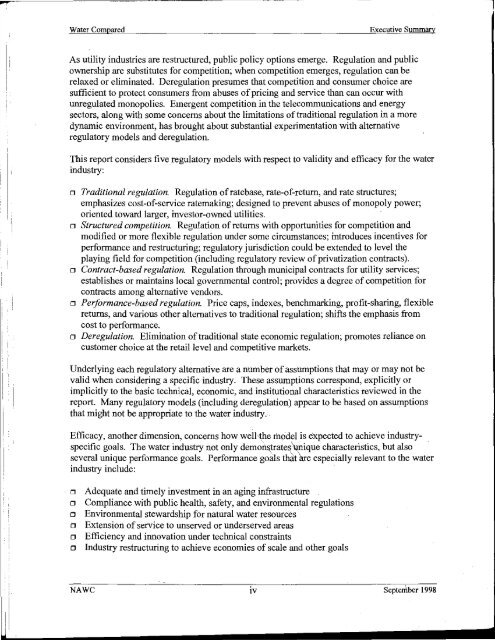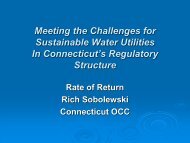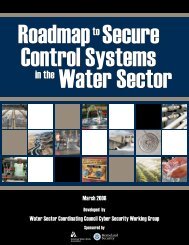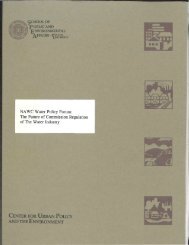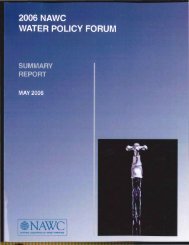BEECHER - NAWC
BEECHER - NAWC
BEECHER - NAWC
You also want an ePaper? Increase the reach of your titles
YUMPU automatically turns print PDFs into web optimized ePapers that Google loves.
Water ComparedExecutive SummaryAs utility industries are restructured, public policy options emerge. Regulation and publicownership are substitutes for competition; when competition emerges, regulation can berelaxed or eliminated. Deregulation presumes that competition and consumer choice aresufficient to protect consumers from abuses of pricing and service than can occur withunregulated monopolies. Emergent competition in the telecommunications and energysectors, along with some concerns about the limitations of traditional regulation in a moredynamic enviroument, has brought about substantial experimentation with alternativeregulatory models and deregulation.This report considers five regulatory models with respect to validity and efficacy for the waterindustry:o Traditional regulation. Regulation of rate base, rate-of-return, and rate structures;emphasizes cost-of-service ratemaking; designed to prevent abuses of monopoly power;oriented toward larger, investor-owned utilities.o Structured competition. Regulation of returns with opportunities for competition andmodified or more flexible regulation under some circumstances; introduces incentives forperformance and restructuring; regulatory jurisdiction could be extended to level theplaying field for competition (including regulatory review of privatization contracts).o Contract-based regulation. Regulation through municipal contracts for utility services;establishes or maintains local governmental control; provides a degree of competition forcontracts among alternative vendors.o Performance-based regulation. Price caps, indexes, benchmarking, profit-sharing, flexiblereturns, and various other alternatives to traditional regulation; shifts the emphasis fromcost to performance.o Deregulation. Elimination of traditional state economic regulation; promotes reliance oncustomer choice at the retail level and competitive markets.Underlying each regulatory alternative are a number of assumptions that may or may not bevalid when considering a specific industry. These assumptions correspond, explicitly orimplicitly to the basic technical, economic, and institutional characteristics reviewed in thereport. Many regulatory models (including deregulation) appear to be based on assumptionsthat might not be appropriate to the water industry.Efficacy, another dimension, concerns how welHhe rtuidel is expected to achieve industryspecificgoals. The water industry not only demon~trates \mique characteristics, but alsoseveral unique performance goals. Performance gmils ~'t 'are especially relevant to the waterindustry include:o Adequate and timely investment in an aging infrastructureo Compliance with public health, safety, and environmental regulationso Environmental stewardship for natural water resourceso Extension of service to unserved or underserved areaso Efficiency and innovation under technical constraintso Industry restructuring to achieve economies of scale and other goals<strong>NAWC</strong> IV Septeniber 1998


